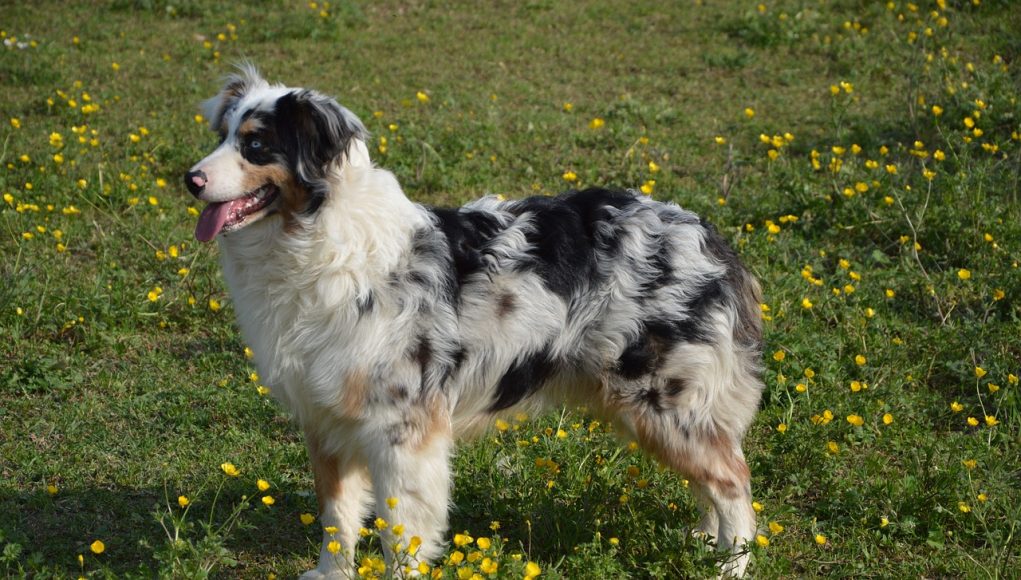The Australian Shepherd, commonly known as the « Aussie, » is a versatile and intelligent breed admired for its herding abilities, agility, and striking appearance.
Despite its name, the Australian Shepherd was developed in the United States, not Australia. This article delves into the breed’s history, physical characteristics, temperament, care requirements, health concerns, and more.
Australian Shepherd : A Complete Guide to This Dog Breed
Whether you’re considering adopting an Australian Shepherd or are simply curious about this energetic breed, this guide provides everything you need to know.
The Origins
The Australian Shepherd’s history is somewhat mysterious. Contrary to its name, the breed was actually developed in the United States during the 19th century. It is believed that the name « Australian Shepherd » may have originated from associations with Basque shepherds who came to America from Australia with their herding dogs.
These dogs were then crossbred to create the hardworking, agile, and intelligent breed we know today. Australian Shepherds were primarily used to herd livestock, and they quickly became popular on ranches and farms due to their versatility and work ethic.
Fun Fact: Australian Shepherds were frequently featured in rodeos and horse shows, performing impressive tricks and herding demonstrations, which helped to popularize the breed across the United States.
Physical Characteristics of the Australian Shepherd
Australian Shepherds are known for their athletic build and stunning coats, which come in a variety of colors and patterns. Here’s a detailed look at their physical traits:
- Size: Australian Shepherds are medium-sized dogs, typically weighing between 40-65 pounds (18-29 kg) for males and 35-55 pounds (16-25 kg) for females.
- Height: They stand about 18-23 inches (46-58 cm) tall at the shoulder.
- Coat Color: Aussies have a thick double coat that can be straight or wavy. Their coats come in several color combinations, including blue merle, red merle, black, and red, often with white and tan markings.
- Morphology: Australian Shepherds have a muscular and agile build with a strong, well-proportioned body. Their eyes can be brown, blue, or even one of each, adding to their unique appearance. Their ears are medium-sized and set high, and their tails are often naturally bobbed or docked.
- Distinctive Features: One of the most striking features of the Australian Shepherd is its merle coat pattern, which creates a marbled or speckled appearance. Their bright, expressive eyes and alert demeanor give them a focused and intelligent look.
Comparison: Compared to other herding breeds like the Border Collie, Australian Shepherds are slightly larger and have a more robust build. They also tend to have a more diverse range of coat colors and eye combinations.

The Temperament
Australian Shepherds are known for their intelligence, energy, and loyalty. They are highly trainable and excel in various activities, from herding to obedience and agility.
- Interaction with Children: Aussies are typically great with children, especially when socialized early. Their protective and affectionate nature makes them excellent family dogs, though they may attempt to herd small children, a behavior that can be managed with proper training.
- Behavior with Other Animals: Australian Shepherds generally get along well with other pets, particularly if they are raised together. They may be cautious around unfamiliar animals and will often try to herd them.
- Training Tips: Due to their intelligence and eagerness to please, Australian Shepherds thrive in structured training environments. They respond well to positive reinforcement and enjoy learning new tricks and tasks. Training should be consistent and engaging to keep them mentally stimulated.
Care Needs for the Australian Shepherd
Australian Shepherds are active dogs that require regular exercise, mental stimulation, and grooming.
- Coat Maintenance: The Australian Shepherd’s coat needs regular brushing, at least two to three times a week, to manage shedding and prevent matting, especially during seasonal shedding periods. Occasional baths help maintain their coat’s cleanliness.
- Exercise Requirements: Aussies are highly energetic and need daily physical activity to stay healthy. They enjoy a variety of activities, such as running, hiking, and playing fetch. They are well-suited for active owners and thrive in homes with large yards, but they can adapt to apartment living if they receive ample exercise.
- Hygiene and Specific Care: Regular ear cleaning, dental care, and nail trimming are essential for Australian Shepherds. Their ears, which hang close to the head, can be prone to infections, so keeping them clean and dry is important.
Common Health Issues in Australian Shepherds
Australian Shepherds are generally healthy dogs, but like all breeds, they are prone to certain health conditions.
- Hip Dysplasia: This is a common condition where the hip joint doesn’t fit properly, which can cause discomfort and mobility issues as the dog ages.
- Elbow Dysplasia: Similar to hip dysplasia, elbow dysplasia affects the front legs and can lead to lameness.
- Eye Conditions: Aussies are prone to several genetic eye issues, including cataracts and progressive retinal atrophy (PRA). Regular eye exams and genetic testing can help detect these conditions early.
- Life Expectancy: The average lifespan of an Australian Shepherd is 12-15 years. Maintaining a healthy lifestyle with proper exercise, diet, and regular vet visits can help maximize their lifespan.
Life Expectancy and Quality of Life of Australian Shepherds
On average, Australian Shepherds live between 12 to 15 years. Their quality of life largely depends on their activity level, mental stimulation, and overall health care.
- Maximizing Quality of Life: To ensure an Aussie lives a long and happy life, provide them with regular physical activity, interactive toys, and training sessions. A balanced diet and routine veterinary visits are also crucial for preventing health issues and maintaining their well-being.
Pros and Cons of Owning an Australian Shepherd
Advantages:
- Australian Shepherds are highly intelligent and excel in obedience and agility training.
- They are loyal, protective, and make excellent companions for active families or individuals.
- Their versatility allows them to adapt to various dog sports and activities, making them great partners for outdoor adventures.
Disadvantages:
- Aussies require a high level of physical and mental stimulation, which may not suit all owners.
- They shed heavily, requiring frequent grooming.
- Their herding instinct can lead to nipping or chasing behaviors if not properly managed through training.
What to Know Before Adopting an Australian Shepherd
Australian Shepherds are best suited for active owners who can provide them with the exercise and mental stimulation they need. Ideal owners include those who enjoy outdoor activities such as running, hiking, and agility training. Aussies do well in environments where they have space to run and play, but they can also adapt to smaller living spaces if their exercise needs are met.
Before adopting an Aussie, it’s essential to understand their high energy levels and commitment to grooming. Consulting with breeders or rescue organizations can help prospective owners make an informed decision about whether the Australian Shepherd is the right fit for their lifestyle.
Comparing the Australian Shepherd with the Border Collie
While both breeds are highly intelligent and excellent herders, Australian Shepherds tend to be slightly larger and have a more muscular build compared to Border Collies. Border Collies are often considered the more intense of the two breeds, requiring even more mental stimulation and activity than Aussies.
Australian Shepherds are energetic, intelligent, and loyal companions that excel in various roles, from herding to family pets. However, they require an active and engaged owner who can meet their physical and mental needs.
Proper research and consulting with professionals or breeders are crucial for ensuring that adopting an Aussie is the right choice for a long and fulfilling companionship.









